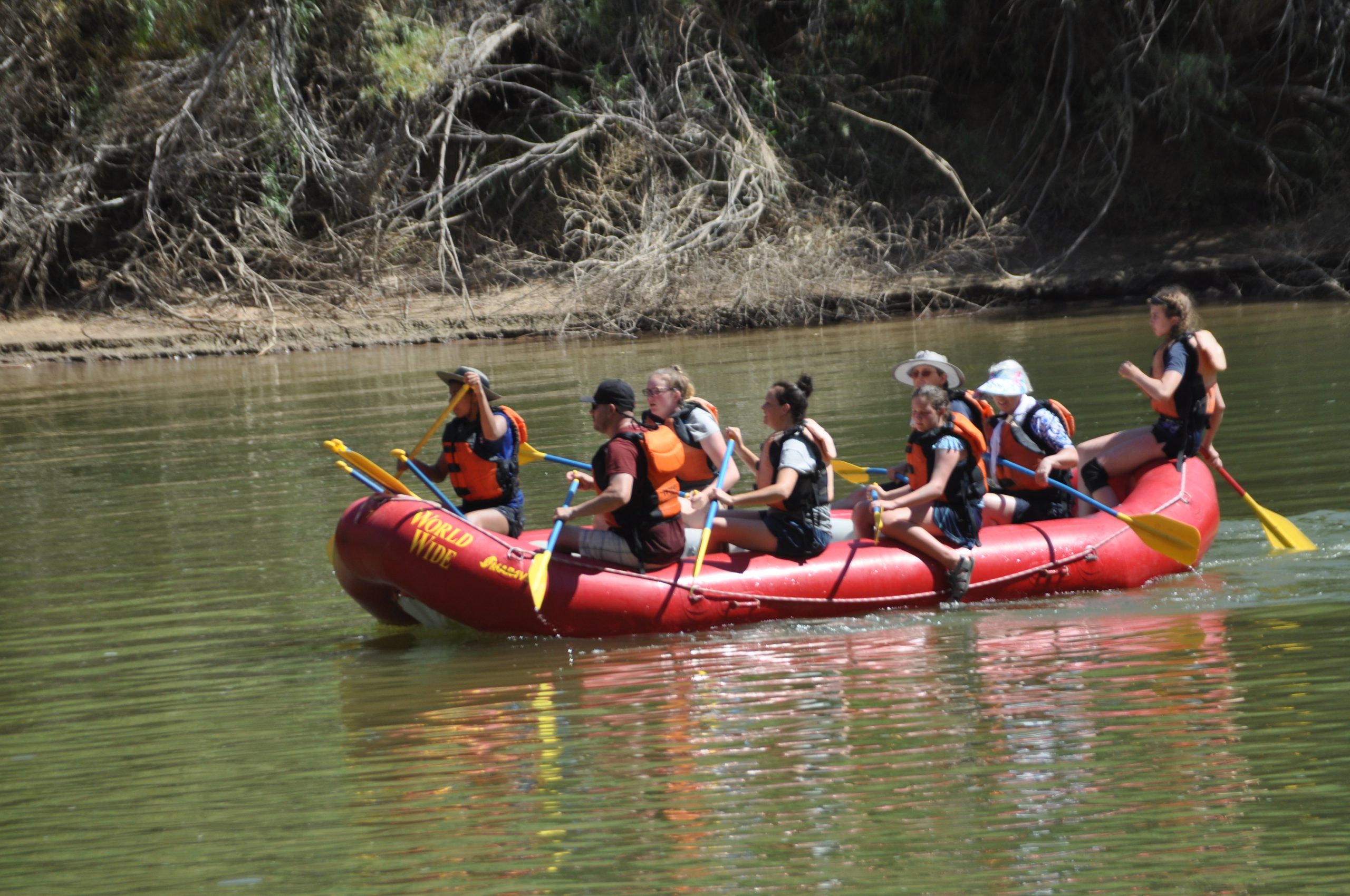Some information may be outdated.
When Karla VanderZanden, longtime Moabite, founder of Canyonlands Field Institute, and seasoned whitewater rafter, is asked about what she’s expecting on the river this year, following the record-breaking snowy winter, she brings up 1983 and 1984.
In 1983, she was working as a river ranger on Westwater Canyon, the first whitewater stretch of the Colorado River in Utah. The canyon is 17 miles long, from the state border with Colorado to the takeout point near Cisco; in an average water year, the canyon offers multiple Class III and Class IV rapids (whitewater rapids are rated on a scale of I to VI). The spring of 1983 was not an average year.
Much like this year, it followed a record-breaking winter. Spring temperatures, instead of rising slowly, allowing snow to then melt slowly, exploded upwards. The Colorado River swelled with water, causing flooding throughout the entire basin—VanderZanden remembers being evacuated by helicopter from the Westwater Ranger Station when the water got too high. When she was allowed to return, she said, the river was so high and moving so swiftly that traveling the Loma Boat Launch in Grand Junction down to Cisco only took a few hours.
The flooding continued through 1984, causing Cataract Canyon—the intense and splashy stretch between the confluence of the Colorado and Green rivers and Lake Powell—to peak at over 100,000 cubic feet per second (the average CFS for the canyon during the main rafting season, May to October, hovers around 40,000).
That’s the big buzz this year, VanderZanden said: will the Colorado River reach the same levels it did in ’83 and ’84? And what will rafting companies and recreationists do if it does?
“There’s a lot of hype,” VanderZanden said. “We talk about it every day.”
Looking back to 1983
The main similarity (from the river’s standpoint) between 2023 and 1983 is the snowpack: bigger snowpacks mean bigger runoffs into the Colorado River. Already the Colorado is flooding—spots where creeks run into the river, like at Jackson’s Trail off Kane Creek Boulevard and at the Matheson Wetlands, are being flooded, backwashed, by the Colorado.
According to the U.S. Geological Survey river gauge near Cisco, the water flow has already surpassed last year’s peak (on May 1, 2023, the river was running at 19,500 CFS; it peaked last year on May 20 at 16,300). That’s where companies will usually put in to run Westwater Canyon; that’s the gauge they’ll use too to track if The Daily, another popular stretch, is runnable.
Measurements at the Potash gauge show a similar story: on May 2, 2023, the river was running at 22,100 CFS; it peaked last year on May 20 at 16,500. That’s where companies will put in to run Cataract.
The Colorado is still a few weeks out from hitting its peak. In ’83, Cataract Canyon peaked at 104,700 CFS in late June; in ’84, it peaked at 114,900 CFS in late May.
Guides consider safety for high-water trips
During high water seasons, rafting guides can expect a few things: more debris in the river, and more likelihood that the boat will flip. VanderZanden said debris is a huge issue—whole trees can get caught on rocks in the river, changing the river’s course and the rafter’s ability to take a particular line down a rapid, and debris will gather into eddies, obstructing a rafter’s ability to paddle through them.
VanderZanden said to stay safe, anyone planning to recreate on the river should know what they’re getting into by checking the CFS and always wear a lifejacket.
Guides at CFI—the organization VanderZanden founded, which focuses its rafting on outdoor education—are trained over the course of five weeks, according to Education Director Alexander de Moor. Not much changes about training for high water seasons, he said, because guides are always trained to be prepared for anything: CFI guides receive Wilderness First Responder certifications, CPR and First Aid certifications, and training on what to do if a boat flips or if someone takes an accidental swim. CFI’s cutoff for running Westwater Canyon is 20,000 CFS.
CFI doesn’t run trips down Cataract Canyon, but of the Moab companies contacted by the Moab Sun News that do, all are planning to take trips down the canyon this year.
Sheri Griffith River Expeditions said staff notified everyone who booked a Cataract trip that there will be high waters, meaning a higher potential for boat flips and unplanned swims. The majority of guests booked another trip—Desolation Canyon is a popular alternative—but some opted to continue down Cataract.
Mild2Wild staff said they track the CFS gauges every day. They’re also opting to take rafters down in bigger boats—up to 32 feet—and have a number of backup rivers in mind. The Dolores River, which is typically too low to raft, will be high enough this year to support trips.
Jason Taylor, the Moab Operations Manager for Western River Expeditions and the Moab Adventure Center (and Moab city councilmember), said guides for Western River are doing extra training trips to prepare. He’s keeping all guests in the loop about the high water, and also opting to put everyone on larger J-rig boats. Western River Expeditions doesn’t have a CFS cutoff point, but Taylor said staff are monitoring water levels for each trip and will make decisions on a week-by-week basis.
Myke Hughes, the owner of Adrift Adventures, said his company is only sending seasoned guides down Cataract in J-rigs as well. He’s also been contacting other local companies to see if they could run trips together so the guides have more support in the canyon.
“I wish I had a crystal ball,” Hughes said. “But my best bet is we get to 80- or 90-thousand CFS.”
Appreciate the coverage? Help keep local news alive.
Chip in to support the Moab Sun News.





